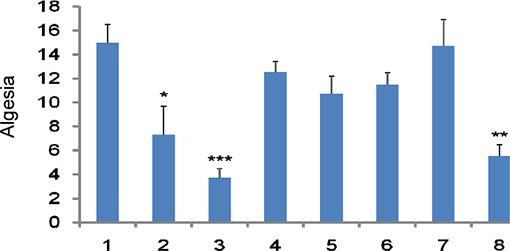Nevirapine abolishes analgesic effect of artemether in malaria-infected mice Artemether (ART) and nevirapine (NVP) are known to be relatively safe drugs used in combination with other drugs in the treatment and management of malaria and HIV infection respectively in many parts of the world. Pain (algesia) is an integral symptom of malaria and some opportunistic infections in HIV/AIDS; and ART has been reported to have mild analgesic effect (1). This study investigated the effect of co-administration of ART and NVP on algesia in both non-immuno-compromised and immuno-compromised malaria-infected mice. 
Experimental Groups *P<0.05, **P<0.001,*** P<0.0001 (ANOVA, Dunnett’s Post-hoc) 1: un-infected, 2-8: P. berghei-infected on day 12; Below: drug treatments for days 1-14, 15-20, 21 1: T80, T80, T80; 2: T80, ART5, ART5; 3: T80, ART10, ART10; 4: NVP, NVP, NVP; 5: NVP, ART5+NVP, ART5+NVP; 6: NVP, ART10+NVP, ART10+NVP; 7: T80, T80, T80; 8: T80, T80, T80+PRX Acetic acid-induced writhes on day 21 Acetic acid-induced writhing method was used for assessing algesia / analgesic (pain-relieving) effect (2). In Experiment 1, non-immuno-compromised Swiss albino mice were divided into 8 groups of 5 each. Groups 4, 5 and 6 received 30 mg/kg NVP daily for 20 days. From days 15 to 20, groups 2 and 5 received artemether, 5 mg/kg (ART5) while groups 3 and 6 received 10 mg/kg (ART10). Groups 1, 7 and 8 received equivalent volumes of vehicle (3% v/v Tween 80), daily for 20 days. All mice except those in group 1 were infected with Plasmodium berghei on day 12. In the latter 12 hours of day 20, all mice were fasted to aid detection of acetic acid-induced writhes. On day 21, the treatment outlined above was repeated, except that group 8 received 20 mg/kg piroxicam (PRX). Thirty minutes after individual mouse treatment, 0.6% acetic acid was administered at the dose of 10 ml/kg; after which writhes were counted for 10 minutes. All drugs administration and parasite inoculation were via intraperitoneal route. All experiments were done according to international ethical standards regarding the handling and use of laboratory animals. In Experiment 2, dexamethasone (DEX) 20 mg/kg on day1 followed by booster doses of 10 mg/kg and 5 mg/kg on days 8 and 15 respectively was used to achieve immuno-suppression in all groups except group 1; and the above protocol was repeated. Data were analysed using ANOVA, followed by Dunnett’s post hoc test. ART significantly (P<0.05-0.0001) inhibited pain in a dose-dependent manner comparable to PRX, and this effect was abolished when NVP was administered (Fig. 1). Similar but less profound effects were observed in immuno-compromised mice. In conclusion, the data suggests that pain-reducing effect of ART was abolished in the presence of NVP. (1) Ejiofor JI, Kwanashie HO & Anuka JA (2007) J Pharm Bioresources 4: 39-48. (2) Koster R, Ahderson M, de Beer EJ (1959) Fed Proc 18: 412.
|


